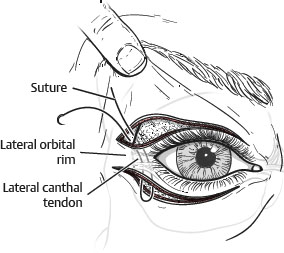38. Lateral Canthopexy
Jason K. Potter, Steve Fagien
■ Lateral canthopexy is an important adjunctive procedure to plastic surgeons performing blepharoplasty surgery.
■ Classically, lateral canthopexy was reserved for lax lower eyelids or with correction of lower eyelid deformities.
■ Distortion of the lower lid is the most common complication of lower lid blepharoplasty.1
• Malposition results from the interaction of the patient’s anatomy, the effects of mechanical distraction secondary to cicatricial and gravitational forces, and attenuation of lid supporting structures.
• Secondary forces result from eyelid edema, hematoma, chemosis, and disruption of orbicularis innervations.
■ Lateral canthopexy should be considered as a routine component of lower blepharoplasty in the appropriate patient.2,3
■ Contemporary blepharoplasty techniques aim to correct more than merely skin laxity and therefore have the potential for increased distracting forces on the lower lid.
• These techniques should be used in conjunction with the consideration of routine lateral canthopexy.4
TERMINOLOGY (Fig. 38-1)

Fig. 38-1 Lateral retinacular suspension. Performed most often through the existing upper and lower blepharoplasty incision. The release allows for disinsertion of the superficial component of the lateral canthal tendon from the orbicularis muscle. A double-armed suture is placed from the lower blepharoplasty incision and passes superolateral to the internal orbital rim periosteum above Whitnall tubercle and exits the lateral upper eyelid incision. This direction can be vectored according to the patient’s unique presentation and orbital morphology.
■ Lateral canthopexy: Tightening of the lateral canthus while maintaining the lateral attachment of the canthus to the orbital rim
■ Lateral canthoplasty: Tightening or repositioning the lateral canthus using transection or resection and repositioning of the lateral canthal attachment to the orbital rim
TIP: These terms are sometimes used interchangeably and a canthopexy, as originally described by Flowers et al,5 was a simple suture canthal suspension without any release. A canthoplasty was used to indicate surgical division of the lateral commissure in preparation for a horizontal shortening procedure such as the lateral tarsal strip (LTS) procedure. The LTS or surgical cantholysis of the lateral commissure is rarely necessary in primary cosmetic lower blepharoplasty.
ABSOLUTE INDICATIONS FOR LATERAL CANTHOPEXY
■ Lower lid deformity: Any procedure attempting to correct a preexisting lower lid deformity, even in a situation of primary blepharoplasty without prior surgery, should incorporate a lateral canthopexy.
• Scleral show between the lower lid margin and inferior limbus may indicate lower lid deformity.
• Canthal dystopia where the lateral canthal position is caudal to the lid margin and/or medial canthus.
■ Lower lid laxity: Lower lid laxity is an indication for lateral canthopexy and is critical in preventing lid deformities from blepharoplasty when any significant tension is created, either with a skin or skin/muscle flap or skin resurfacing.
• Distraction (pull-away) test: Manual anterior distraction of the lid from the globe >10 mm indicates significant lid laxity.
• Snap-back test: Lid is pulled inferiorly and released to assess the speed of return to its normal position. Delayed return or persistent eversion indicates lid laxity.
RELATIVE INDICATIONS FOR LATERAL CANTHOPEXY
■ Any blepharoplasty procedure involving more than isolated transconjunctival fat removal or isolated minimal skin excision
PREOPERATIVE EVALUATION
■ Seven key examination findings in preoperative preparation6
1. Vector analysis
2. Tarsoligamentous integrity
3. Scleral show
4. Canthal tilt
5. Distance from lateral canthus to orbital rim soft tissue
6. Midface projection and position
7. Vertical restriction
CHARACTERIZATION OF LOWER LID DEFORMITY
■ Understanding the cause of a lower lid deformity is essential in selecting a lateral canthopexy technique.
• Senile ectropion: Results from acquired laxity of the normal lower lid support mechanism
► Manual elevation of the lid to or beyond the superior limbus
► Traditional canthopexy techniques will provide sufficient augmentation of lower lid support to prevent deformity postoperatively.
• Cicatricial ectropion: Results from contractile forces of the scarring process; may occur secondary to prior surgery, injury, or inflammatory process
► Manual elevation of the lid displays minimal superior excursion of the lid from its retracted position.
► Correction of cicatricial ectropion benefits from powerful canthopexy techniques (transosseous) to counteract the forces of scarring and prevent recurrent deformity.
TECHNIQUES
SUPERFICIAL RETINACULAR LATERAL CANTHOPEXY
■ Involves tightening lateral retinaculum to superomedial aspect of lateral orbital rim6 (Fig. 38-2)








